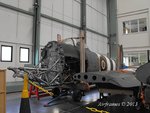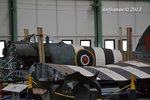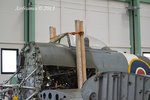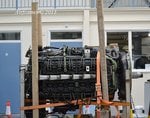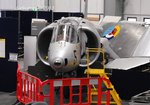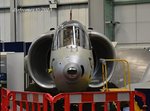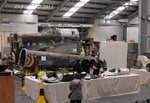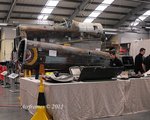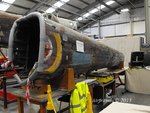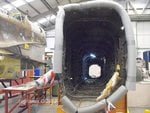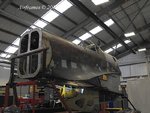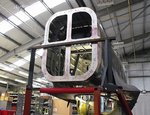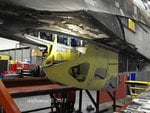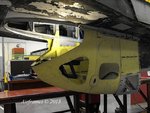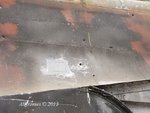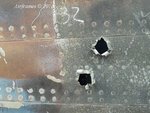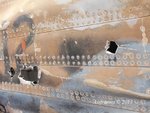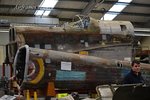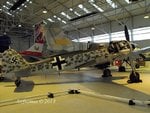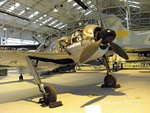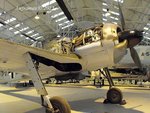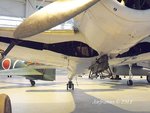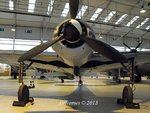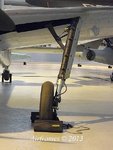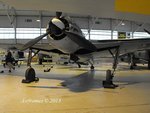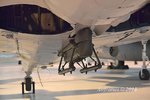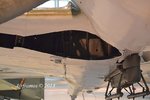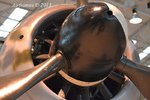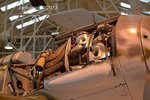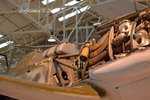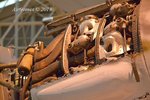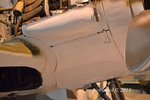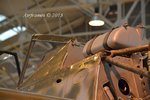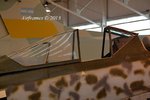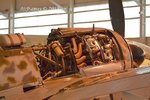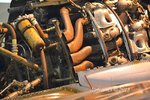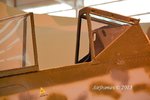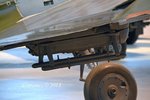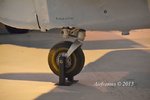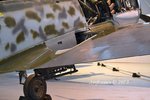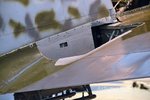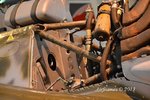Airframes
Benevolens Magister
The Sir Michael Beetham Conservation Center is part of 'the other' RAF Museum, based at the DCAE airfield at Cosford, not far from Wolverhampton, UK.
It is here, in this dedicated facility, where all restoration and conservation work is undertaken on the exhibits in, or for, the the two RAF Museum sites, with the latest aircraft being the Dornier Do17, shot down during the BoB and rescued from the English Chabel in June this year, currently undergoing long-term stabilsation of the airframe, before major conservation and preservation work is commenced.
(I included some photos of this in my recent thread on Cosford and, as time was limited during my visit yesterday, I didn't take any furhter photos, concentrating instead on the other unique aircraft currently undergoing restorative or re-build work.)
The Center is not normally open to the public, but I'd been informed, as a Museum member, that for this week only, the doors were open, and staff on hand to answer questions, between 10.15 and 13.00 hours. As Mick and I had been delayed by unforseen traffic problems, we didn't arrive on site until 12.50, so only had a very short time in which to get to the hangar and view the aircraft, and no time at all in which to bombard the staff with the long list of questions I had mentally prepared.
However, I did manage to get a few photos of the aircraft I specifically wanted to see in this, the last chance to do so, close up, during my remaining time on this planet.
The aircraft in question are the Vickers Wellington, Handley Page Hampden, Hawker Typhoon, and Focke Wulf FW-190, the latter now complete and on display in the War Planes hangar at the Museum.
So, to start, here's the Wellington.
This is a Wellington B.Mk.X, serial number MF628.
Originally built as a bomber, but later converted as a Navigational Trainer, the aircraft had been on display at the RAFM, Hendon for many years, before being transported to Cosford, in 2010, for an overhaul and conservation programme, estimated to take five years.
As the only way to asses the structural integrity of the airframe was to strip it down to bare components, this was started by removing the fabric covering, when remarkably little corrosion was found. The aircraft is now a shell, with most internal fittings removed, to be renovated as required, and this is clearly seen in the photos posted below.
This was the last Wellington to enter service with the RAF, and is also 'famous' for its appearance in the 1954 movie 'The Dambusters', when it not only 'starred' as the aircraft used in the trials of the 'Upkeep' mine, but also acted as camera ship.
As can be seen, all the fabric has been removed, some structural renovation has been undertaken, and the majority of internal fittings, mainly in the cockpit and radio operator's position, have been removed for individual restoration or servicing. the long tables in the center section are a 'left over' from it's Navigational Trainer role, and a life size photo of the cockpit, before restoration commenced, stands alongside the fuselage and wings, a shot of which is also included here.
I hope you enjoy these unique views, and I'll post photos and stories on the other aircraft over the next few days.
It is here, in this dedicated facility, where all restoration and conservation work is undertaken on the exhibits in, or for, the the two RAF Museum sites, with the latest aircraft being the Dornier Do17, shot down during the BoB and rescued from the English Chabel in June this year, currently undergoing long-term stabilsation of the airframe, before major conservation and preservation work is commenced.
(I included some photos of this in my recent thread on Cosford and, as time was limited during my visit yesterday, I didn't take any furhter photos, concentrating instead on the other unique aircraft currently undergoing restorative or re-build work.)
The Center is not normally open to the public, but I'd been informed, as a Museum member, that for this week only, the doors were open, and staff on hand to answer questions, between 10.15 and 13.00 hours. As Mick and I had been delayed by unforseen traffic problems, we didn't arrive on site until 12.50, so only had a very short time in which to get to the hangar and view the aircraft, and no time at all in which to bombard the staff with the long list of questions I had mentally prepared.
However, I did manage to get a few photos of the aircraft I specifically wanted to see in this, the last chance to do so, close up, during my remaining time on this planet.
The aircraft in question are the Vickers Wellington, Handley Page Hampden, Hawker Typhoon, and Focke Wulf FW-190, the latter now complete and on display in the War Planes hangar at the Museum.
So, to start, here's the Wellington.
This is a Wellington B.Mk.X, serial number MF628.
Originally built as a bomber, but later converted as a Navigational Trainer, the aircraft had been on display at the RAFM, Hendon for many years, before being transported to Cosford, in 2010, for an overhaul and conservation programme, estimated to take five years.
As the only way to asses the structural integrity of the airframe was to strip it down to bare components, this was started by removing the fabric covering, when remarkably little corrosion was found. The aircraft is now a shell, with most internal fittings removed, to be renovated as required, and this is clearly seen in the photos posted below.
This was the last Wellington to enter service with the RAF, and is also 'famous' for its appearance in the 1954 movie 'The Dambusters', when it not only 'starred' as the aircraft used in the trials of the 'Upkeep' mine, but also acted as camera ship.
As can be seen, all the fabric has been removed, some structural renovation has been undertaken, and the majority of internal fittings, mainly in the cockpit and radio operator's position, have been removed for individual restoration or servicing. the long tables in the center section are a 'left over' from it's Navigational Trainer role, and a life size photo of the cockpit, before restoration commenced, stands alongside the fuselage and wings, a shot of which is also included here.
I hope you enjoy these unique views, and I'll post photos and stories on the other aircraft over the next few days.
Attachments
-
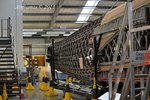 Cosfd Consv 1.jpg185 KB · Views: 171
Cosfd Consv 1.jpg185 KB · Views: 171 -
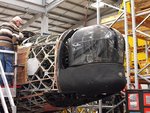 Cosfd Consv 2.jpg148.9 KB · Views: 152
Cosfd Consv 2.jpg148.9 KB · Views: 152 -
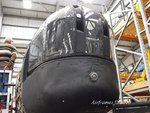 Cosfd Consv 3.jpg126.1 KB · Views: 153
Cosfd Consv 3.jpg126.1 KB · Views: 153 -
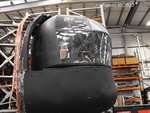 Cosfd Consv 4.jpg131.2 KB · Views: 159
Cosfd Consv 4.jpg131.2 KB · Views: 159 -
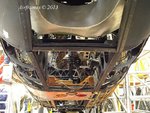 Cosfd Consv 5.jpg135.9 KB · Views: 155
Cosfd Consv 5.jpg135.9 KB · Views: 155 -
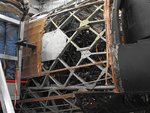 Cosfd Consv 6.jpg140.8 KB · Views: 147
Cosfd Consv 6.jpg140.8 KB · Views: 147 -
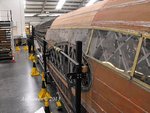 Cosfd Consv 7.jpg129.3 KB · Views: 154
Cosfd Consv 7.jpg129.3 KB · Views: 154 -
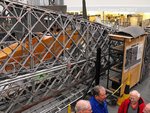 Cosfd Consv 8.jpg176.1 KB · Views: 154
Cosfd Consv 8.jpg176.1 KB · Views: 154 -
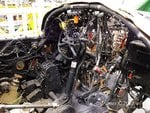 Cosfd Consv 9.jpg159.6 KB · Views: 156
Cosfd Consv 9.jpg159.6 KB · Views: 156 -
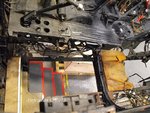 Cosfd Consv 10.jpg138.3 KB · Views: 162
Cosfd Consv 10.jpg138.3 KB · Views: 162 -
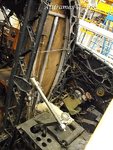 Cosfd Consv 11.jpg92.7 KB · Views: 153
Cosfd Consv 11.jpg92.7 KB · Views: 153 -
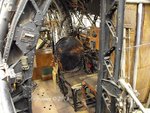 Cosfd consv 12.jpg143.9 KB · Views: 150
Cosfd consv 12.jpg143.9 KB · Views: 150 -
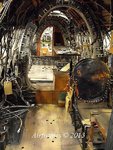 Cosfd consv 13.jpg103.6 KB · Views: 155
Cosfd consv 13.jpg103.6 KB · Views: 155 -
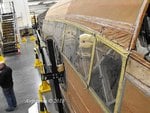 Cosfd consv 14.jpg134.7 KB · Views: 169
Cosfd consv 14.jpg134.7 KB · Views: 169 -
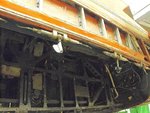 Cosfd Consv 15.jpg144.1 KB · Views: 155
Cosfd Consv 15.jpg144.1 KB · Views: 155 -
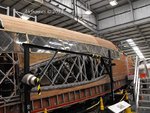 Cosfd consv 16.jpg152.9 KB · Views: 163
Cosfd consv 16.jpg152.9 KB · Views: 163 -
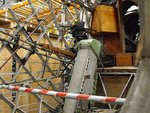 Cosfd Consv 17.jpg146.4 KB · Views: 149
Cosfd Consv 17.jpg146.4 KB · Views: 149 -
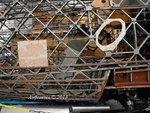 Cosfd Consv 18.jpg168.9 KB · Views: 152
Cosfd Consv 18.jpg168.9 KB · Views: 152 -
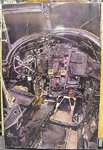 Cosfd Consv 19.jpg108.6 KB · Views: 165
Cosfd Consv 19.jpg108.6 KB · Views: 165 -
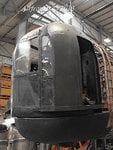 Cosfd consv 20.jpg82.5 KB · Views: 158
Cosfd consv 20.jpg82.5 KB · Views: 158 -
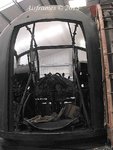 Cosfd Consv 21.jpg77.1 KB · Views: 156
Cosfd Consv 21.jpg77.1 KB · Views: 156 -
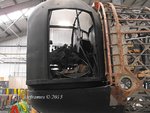 Cosfd Consv 22.jpg132 KB · Views: 156
Cosfd Consv 22.jpg132 KB · Views: 156

